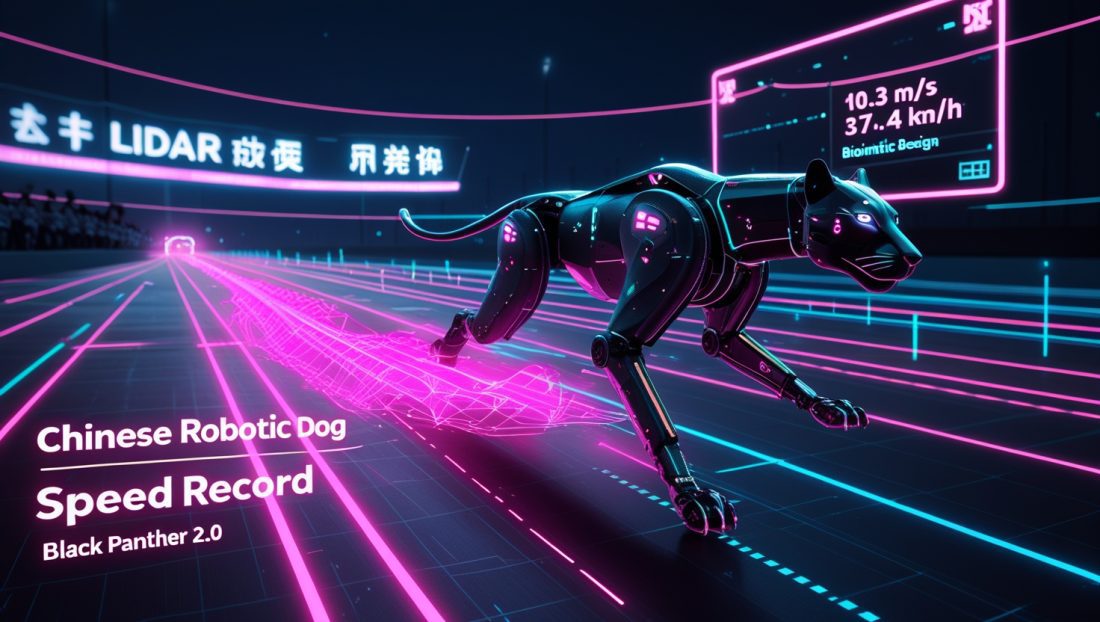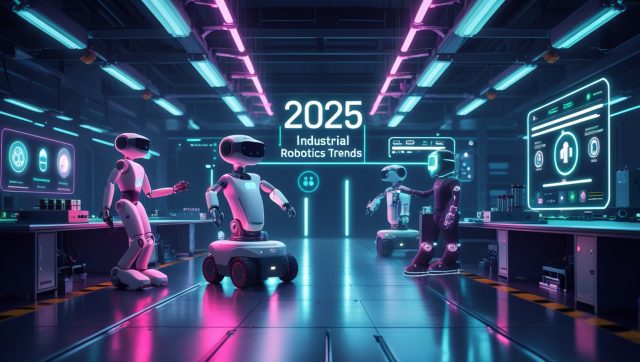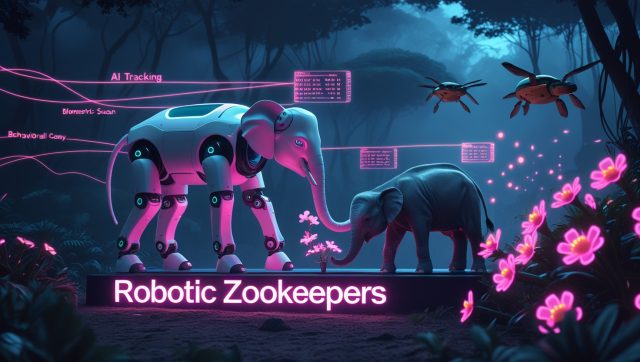(Beijing, July 7, 2025) — Can machines outrun humanity’s greatest athletes? China answered decisively with the Chinese robotic dog speed record set by Zhejiang University’s Black Panther 2.0, which clocked 10.3 m/s (37.4 km/h) in a live demonstration, nearly matching Usain Bolt’s 10.44 m/s world-record sprint. This breakthrough signals a quantum leap in industrial robotics, with seismic implications for disaster response, military operations, and automated logistics.
Engineering Marvel Behind the Chinese Robotic Dog Speed Record
During CCTV’s nationally televised broadcast, the 38kg quadruped maintained record velocity for 10 seconds on a treadmill. Unlike Boston Dynamics’ discontinued Cheetah prototype, Black Panther 2.0 achieves unprecedented speed through three innovations:
- Biomimetic Skeletal Design
Carbon-fiber legs replicate big cats’ spring-tendon systems, absorbing impact forces while optimizing energy transfer. Recent integration of unified limb modules (replacing segmented assemblies) reduced failure points by 40%. For a deeper look at how biomimicry is transforming robotic movement, explore how reinforcement learning is reshaping robotics training, which highlights adaptive algorithms driving such advancements.
- 2. Neuromorphic Processing
Terrain data from LiDAR and infrared sensors feeds a neural network that adjusts gait parameters 5 times per second. This enables instant adaptation to rubble, slopes, or ice—critical for real-world deployment. Similar advancements in sensory processing are revolutionizing other sectors, as seen in AI-driven industrial sound sensing, which uses real-time data to cut factory downtime.
- 3. High-Torque Micro-Motors
Custom actuators generate 380N of force per joint, rivaling biological muscle density. Combined with gripper-footed titanium alloy paws, this delivers explosive acceleration previously unseen in legged robots. For insights into how such motor advancements are enabling precision tasks, check out force-sensitive grippers redefining robotic touch.
Industrial Applications Reshaping Global Markets
Disaster Response Revolution
Following Turkey’s 2023 earthquake, rescuers struggled to navigate collapsed buildings. Black Panther 2.0’s speed and -20°C to 55°C operational range could transform such missions. Project lead Wang Hongtao confirms: “Field testing begins Q1 2026 at Sichuan earthquake simulation sites. These units will carry medical kits through unstable debris.” To understand how robotics is tackling disaster scenarios, IEEE’s Robotics and Automation Letters provides cutting-edge research on autonomous rescue systems.
Military Deployment Acceleration
The Pentagon’s 2024 Vision 2040 report prioritized robotic swarm warfare after Ukraine’s drone successes. China’s People’s Liberation Army (PLA) now tests armed robotic dogs for:
- Urban combat reconnaissance
- Ammunition resupply in active fire zones
- Perimeter surveillance along Himalayan borders
Logistics Automation Breakthrough
Alibaba’s Cainiao Network plans 2026 trials where robotic dogs transport 20kg packages between warehouse stations at 8 m/s. This could reduce Amazon’s current conveyor-to-robot handover delays by 70%. For more on how automation is transforming logistics, EXOTECH Review’s 2025 Warehouse Automation Report highlights global trends in efficiency.
Global Robotics Race: Competitive Analysis
| Metric | Black Panther 2.0 (China) | Boston Dynamics Spot (USA) | DEEP Robotics X20 (China) |
|---|---|---|---|
| Max Speed | 10.3 m/s | 5.8 m/s | 4.9 m/s |
| Payload Capacity | 20 kg | 14 kg | 10 kg |
| Terrain Adaptation | Autonomous real-time adjustment | Pre-programmed modes only | Limited slope navigation |
| Commercial Availability | 2026 (Projected) | Available now | Available now |
| Source: IEEE Robotics and Automation Society, 2025 Global Quadruped Benchmark Report |
China’s Strategic Dominance Explained
Three factors propelled this breakthrough:
- Government-Academia-Industry Synergy
State-funded initiatives like the National Robotics Engineering Hub (est. 2022) accelerated development. Zhejiang University received $47M in grants, compressing R&D cycles from 36 months to 90 days.
- 2. Military-Civil Fusion Doctrine
PLA requirements for battlefield-ready robots directly influenced Black Panther’s waterproofing, dust resistance, and EMP hardening—features later adapted for industrial use.
- 3. Talent Pipeline Expansion
Robotics Ph.D. enrollments tripled since 2020 at Tsinghua and Shanghai Jiao Tong Universities, fueled by “Made in China 2025” scholarships.
Future Trajectory: Beyond Human Limits
Phase 3 development (2026-2028) targets:
- Speed Increase: 19.4 m/s to match ostriches
- Swarm Intelligence: 100+ units collaborating via mesh networks
- Energy Density: Solid-state batteries extending operation from 4 hours to 48 hours
Dr. Elena Rodriguez (MIT Robotics Lab) observes: “China’s solved the locomotion challenge. The next frontier is contextual decision-making during high-speed tasks—like identifying survivors in smoke-filled ruins.”
Evergreen Insights for Tech Strategists
- Biomimicry Efficiency: Nature-inspired designs resolve engineering bottlenecks 30% faster than algorithmic approaches.
- Hardware-Software Convergence: Black Panther’s success emerged from equal investment in materials science and AI training.
FAQ: Addressing Public Curiosity
How much will these robotic dogs cost?
Initial units target $85,000—40% cheaper than Boston Dynamics’ Spot. Mass production could drop prices to $22,000 by 2028.
Could they replace delivery workers?
Short-term, no. Current models lack fine motor skills for package handling. Their role involves transport between fixed nodes.
What ethical safeguards exist?
Zhejiang interviewers’ “Autonomous Systems Ethics Charter” forbids weaponization without human authorization. All military models require two-factor activation.
How weather-resistant are they?
Validated performance in typhoon simulations (150 km/h winds) and desert sandstorms. Icing remains a challenge.
The Path Forward
Black Panther 2.0 transcends a speed record—it redefines robotics’ operational paradigm. As these machines prepare for earthquake zones and warehouse floors, their true impact lies in transforming human-machine collaboration.
“We’re not building replacements for humans,” Wang Hongtao emphasizes. “We’re creating partners that go where we cannot—and return with answers.”
Stay ahead of robotics’ evolution: Subscribe to our Industrial AI newsletter for exclusive deployment updates and tech deep dives.



